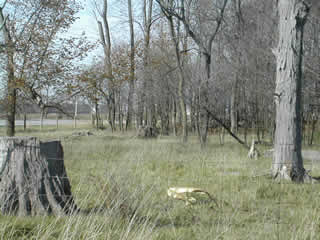|
 Deforestation
and Habitat Destruction Deforestation
and Habitat Destruction
When settlers first came to Indiana in the 1700s,
over twenty million acres of forests covered the land. In
the late 1800s and early 1900s, more than 90 percent, or 18
million acres, were cleared to create farmland for crops and
livestock. In 1929, the Great Depression led many farmers
to leave their land, and the forests had a chance to grow
again. By 1967, the forests in Indiana reached a point where
they covered over 4.1 million acres of land. Today, Indiana
forests shelter more than 4.4 million acres of land, 85 percent
of which are privately owned.
Unfortunately, most people who own private forestland
use their timber for profit, by either selling the land or
using the trees for logging. Indiana, according to the U.
S. Department of Agriculture, "has some of the most productive
timberlands in the United States and is the second leading
producer of hardwood lumber in the nation” ("By
All Measurements"). Many items used in homes now are
made from Indiana trees, and the demand for goods and services
created by forestland continues to increase rapidly.
The combined destruction—resulting from
agriculture, irresponsible logging, urban sprawl, transportation
corridors, and other human activity—has eliminated nearly
all of the old-growth forests in Indiana and fragmented much
of the forest that remains. The negative impact upon wildlife
and plant life has been tremendous. Suitable habitats for
breeding, nesting, and feeding have been irreversibly altered
or destroyed for many species of animals, as forests have
been fragmented into small, isolated woodlots across much
of the state. Many species of warblers, for example, require
large areas of continuous forest habitat, rather than the
shallow margins that dominate when forests are fragmented.
In contrast, the brown-headed cowbird,
which favors wooded margins, has increased in population and
in turn threatened the populations of many Indiana songbirds.
Many organizations now exist to protect existing
forests in Indiana, such as the Indiana Forest Alliance, Heartwood,
the Indiana Society of American Foresters, and various offices
of the state and federal government. Many individuals, likewise,
are taking an interest in preserving the forests for recreational
uses. Teaming with Wildlife, for example, reports that camping
brought $319 million to the state in 1996, representing "a
significant number of people who are enjoying the outdoors
as well as their existing and potential benefits to Indiana's
economy.”
In south central Indiana, the Hoosier
National Forest provides a place where families can go
to enjoy Indiana's wilderness and where thousands of plant
and animal species have become established. Currently, the
forest protects four endangered animal species: the Indiana
bat, gray bat, bald eagle, and fan shell mussel. Over the
years controversies have continued on whether or not logging
should be permitted in the Hoosier National Forest. In 2002,
the controversy included President George Bush’s "Healthy
Forests Initiative," which would allow increased logging
in national forests in order to reduce potential fuel for
forest fires.
The constant threat to Indiana’s forests
will continue as long as people see only the dollar value
of the trees and land. While some logging and destruction
is unavoidable for various reasons, Hoosiers should recognize
how vitally important the forests are to the environment and
the living species that rely on the health and growth of the
forests.
Sources:
“Forests and Forestry in Indiana.”
Dept. of Forestry and Natural Resources, Purdue U. 13 October
2002
<http://www.agriculture.purdue.edu/fnr/Extension/
INForests.htm>.
Indiana Society of American Foresters.
"Position Statements."
13 October 2002 <http://www.indianasaf.org/pos/>.
O'Neill, Charlie. "Legislation
Threatens Bio-diversity in State Forests." Legislative
Issues. Indiana Wildlife Federation.
25 October 2002. <http://www.indianawildlife.org/issues.html>.
United States. Dept. of Agriculture.
Forest Service. North Central Research Station. "By All
Measurements—Indiana’s Forests Are Growing."
2000. 13 October 2002
<http://www.ncrs.fs.fed.us/news/pressreleases/
nrindiana.htm>.
---. Hoosier National Forest. 11 Sept.
2002. 13 October 2002. <http://www.fs.fed.us/r9/hoosier/>.
“Wildlife Funding in Indiana.”
Teaming with Wildlife. 2002. 25 October 2002 <http://www.teaming.com/site/
wildlife_state.cfm?state=Indiana>.
|




